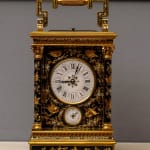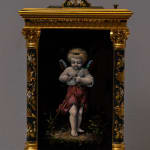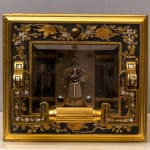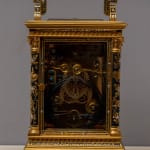A LATE NINETEENTH CENTURY FRENCH CARRIAGE CLOCK WITH GOLD, SILVER AND OTHER METALLIC RELIEF WORK AND ENAMEL PANELS, Paris, date circa 1810
Height 49.5 cm, width 30 cm, depth 16 cm.
Sold
Further images
A rare and extremely beautiful late nineteenth century French carriage clock of eight day duration with case decorated with gold, silver and other metallic relief work and Limoges School revival enamel panels by Théophile Soyer to the sides, the white enamel dial with Roman numerals, each within a gilt shaped cartouche, with an outer minute chapter ring marked with indications and the centre painted with a gilt star-burst, with a fine pair of blued steel hands for the hours and minutes, a subsidiary alarm dial below the main dial marked with Arabic numerals 1-12 with a blued steel pointer. The movement with petite and grande sonnerie, striking on two gongs and request for silent and repeat, the underside of the clock inscribed 1er Janvier 1885 and 1er Avril 1900 (most probably the cleaning dates) above a sliding bar marked: Grande Sonnerie/Petit Sonnerie/Silence. The gilt brass Anglaise Riche case adorned on the front, base and on the handle with multi-coloured relief work in gold, silver and other metals depicting birds amongst flowers and foliage, the front flanked by Corinthian columns, surmounted an angular handle and stepped entablature above a glazed viewing aperture. The sides of the case fitted with Limoges School revival enamel panels by Théophile Soyer, each signed with a monogram composed of the letters T and S, one showing a winged putto wearing a crescent moon headdress and tunic with a metallic blue skirt, holding a dove in one hand and an arrow in the other, the other panel showing a winged putto holding a fish and staff in his hands
Paris, date circa 1875
Height 20.5 cm.
Literature: Charles Terwilliger and Joseph Fanelli, “A Century of Fine Carriage Clocks”, 1987, p. 39, illustrating a very similar carriage clock. Derek Roberts, “Carriage and Other Travelling Clocks”, 1993, p. 160, pl. 9-38, illustrating a carriage clock with very similar impressive metallic relief decoration and pl. 9-37, illustrating a carriage clock with simpler gold and multi-coloured metal work. And p. 105, pl. 6-40, illustrating a very similarly shaped Anglaise Riche carriage clock case, with simpler enamel decoration featuring the same alarm dial below the main dial.
When commenting upon a carriage clock case adorned with very similar multicoloured gold, silver and other metals, Derek Roberts, in his book on carriage clocks (pl. 9-38), notes that its decoration must have been one of the most time-consuming methods. The process initially involved laying out a detailed design. Then, once all the birds, foliage and flowers were delineated, the entire background around them would be removed. When this had been achieved, the birds, flowers and foliage were engraved, after which the case was ready for plating. Initially it was covered in just one colour or one shade of gold. Those parts that were to remain that colour then had to be protected from any further plating by a varnish or lacquer. Following this, the next colour was deposited, and the same process was repeated until all the raised decoration was finished to achieve the correct colour. Should the craftsman make just one mistake then they had no other choice than begin the whole process from the start. This procedure required infinite skill and was even more demanding when decorating the base and handle, where the detail is even finer.
Unlike the similar example illustrated in Derek Roberts’ book, the present example is adorned with Limoges School revival enamel panels to either side. The use of Limoges revival enamel decoration for clocks was popular from about 1870-1910. As here they were usually set against a black background but occasionally on a dark blue ground. Of the highest quality, they are signed with a monogram to include the letter T, around which is entwined the letter S, for Théophile Soyer (1853-1940). The same initials can be seen on Limoges panels portraying a Renaissance lady and courtier adorning a French musical mantel clock with movement by Louis Fernier of circa 1870, owned by Richard Redding Antiques. Another pair of Limoges plaques from the same period, portraying a Renaissance lady and gentleman on horseback, are similarly signed but also include the letter P, which refer to Théophile Soyer’s father Paul, who established a Paris jewellery and goldsmithing business in the rue Saint-Sauveur. It was there that the father and son established their name as master enamellers and enamel painters working in the rival styles. Théophile Soyer gained great repute in making larger plaques in the Limoges School revival. In 1870 he exhibited two enamel plaques portraying classical subjects at the Paris Salon. In 1889 he won a silver medal at the Exposition Universelle, Paris, of which his father was a member of the jury. His enamels were praised for their perfection and described as masters of the past.









